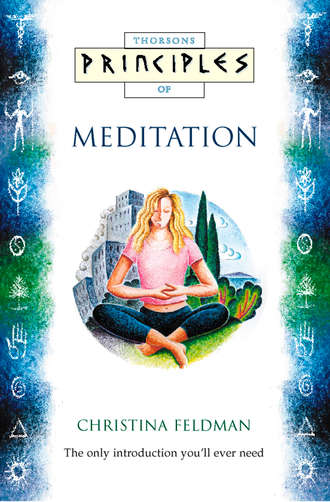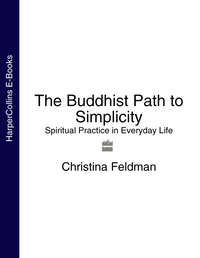
Полная версия
Meditation: The only introduction you’ll ever need
The way of developing concentration is to plant in the foreground of our attention a single subject which we consistently focus upon and return to rather than becoming entangled in any of the stream of events that are occurring in our mind and body. By sustaining this focus the mind will naturally and gradually slow down and the swirl of thoughts will to differing degrees begin to calm and take their place in the background of our consciousness rather than ensnaring us. As our capacity for attention develops it will be increasingly natural for our minds to rest in the focus of our meditation and differing degrees of unity will begin to emerge. There is a growing happiness and sense of wellbeing as we pass though the variety of resistances such as restlessness or dullness that present themselves and the mind finds a certain steadiness and ease in its attention.
Almost anything will serve as a focus for concentration, different temperaments will find affinity with different subjects as the focus for their attention. It is certainly helpful to choose as an object for focus something relatively simple and familiar to us. If we initially select an intricate mandala or complex series of phrases we will make the task of cultivating attention unnecessarily difficult. As our skill in concentration develops we may well choose to direct it towards increasingly complex subjects but in the beginning simplicity is most conducive to calmness.
EXPLORING THE PATH OF CONCENTRATION
Finding a suitable place to practise, adopting a posture that is comfortable to us and bringing to our meditation the spirit of patience and acceptance, we can begin to explore some of the paths of concentration that are widely taught. Don’t be tempted to rush or be overly ambitious, every moment of cultivating attention and oneness is worthwhile. The fruits of our meditation may not be immediately visible to us in the form of tangible results or grand experiences and breakthroughs. Yet every moment we are engaged in bringing our attention back to clarity and single pointedness we are directly engaged in the transformation of our being. We are following the pathways of patience, dedication, clarity and compassion rather than the familiar pathways of resistance, distractedness and reaction.
Initially as you practise you will find that your attention repeatedly wanders away from your chosen subject, becoming lost in memories of the past, plans for the future or preoccupations in the present. We may no sooner return our attention to the present than it departs once more remembering a conversation we had yesterday. We may be tempted to try and analyze the thoughts that present themselves, wonder at their hidden meaning or try to evaluate our progress. It is not uncommon to feel that meditation has produced even more thoughts than before we began to practise. It is more likely we are simply becoming aware of the relentless nature of thought, produced by the mind untrained in attentiveness. Distractedness is a habit of the mind – we are gently learning to disentangle, training the mind in simplicity and clarity. The moment you notice that your attention has wandered away is a moment of returning to attentiveness. Don’t judge or become frustrated with your wandering, simply anchor your attention once more 26 in your meditation subject and begin again. Learning to be attentive you need the patience of a child learning to walk.
CONCENTRATION WITH VISUAL SUBJECTS
A candle flame, a shape, a symbolic object, a mandala or a colour can all serve equally well as a focus for developing attention. The concentration cultivated in relationship to these subjects may serve as a foundation for other devotional and visualization practices later on in the path but initially the objective is to develop a sustained and steady attentiveness. We are integrating our mind and body with the subject of our meditation through sustained attention.

An example of a mandala
Settle yourself in a relaxed and alert posture then place your chosen visual meditation subject just in front of you and bring your eyes to rest upon it. Gently settle your gaze and allow your mind and body to relax. Don’t let your eyes wander around the room but simply fasten your attention upon the object in front of you. Whatever thoughts or bodily sensations arise, give them minimal attention – simply let them flow through you and pass away. As you begin to feel connected with your visual subject, let your eyes close and sustain the visual impression of your subject in your mind. In the beginning you may only be able to do this for a few moments before the visual impression becomes vague or lost. When this happens open your eyes once more and bring your gaze to rest again upon the object in front of you. You may need to do this many times before you find you are able to retain the visual impression of your subject within your mind for longer periods.
As the concentration deepens you will find it less necessary to revert to the external visual connection with your subject as its image becomes more clearly imprinted upon your consciousness in an increasingly sustained way. The image will become increasingly clear in detail and vividness and there will be a greater ease in holding it in the forefront of your consciousness. The thoughts or images that previously appeared to clamour for your attention will begin to quiet and become like whispers arising and passing in the background of your consciousness. This is a sign that your concentration is deepening. Whenever you become distracted, know that you can always open your eyes and return to the direct visual connection with your subject.
As your concentration begins to deepen you may discover that you only need to make a very brief contact with the external visual image in order to trigger the inner imprint. The capacity to recall that inner visual image brings with it qualities of calmness and well being in the mind and body. In deeper levels of concentration the distance or separation between the image and the observer begins to disappear and there is the sense of being absorbed within the visual impression. This experience of absorption triggers deeper levels of happiness, joy and communion. There are different levels of absorption it is possible to realize. The body and mind can become profoundly still to the point where they make no impression upon the consciousness and there is a sense of being saturated with a sublime peace and bliss. It takes considerable practice to reach states of deeper absorption – you should not feel disillusioned if in the early stages of your practice you seem to spend more time disentangling your attention from thought than floating in bliss.
Конец ознакомительного фрагмента.
Текст предоставлен ООО «ЛитРес».
Прочитайте эту книгу целиком, купив полную легальную версию на ЛитРес.
Безопасно оплатить книгу можно банковской картой Visa, MasterCard, Maestro, со счета мобильного телефона, с платежного терминала, в салоне МТС или Связной, через PayPal, WebMoney, Яндекс.Деньги, QIWI Кошелек, бонусными картами или другим удобным Вам способом.



